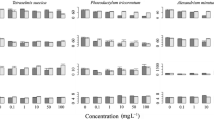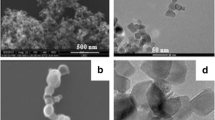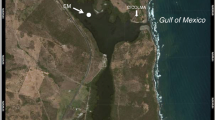Abstract
The aquatic ecosystem is the ultimate sink for consumer and industrial waste discharge that contains nanometals such as titanium dioxide nanoparticle (n-TiO2). In this environment, nutrient availability and nanometals influence phytoplankton community structure and function. In a mesocosm experiment, we evaluated the interactive effect of n-TiO2 (48 mg L−1) and two nitrogen (N) levels (limited, LN; and replete, HN) on the phytoplankton community structure (biomass, species diversity and richness, algal species divisions), biochemical composition (carbohydrates, proteins, and lipids), and antioxidant response (peroxidase activity, POD). n-TiO2 decreased total phytoplankton biomass, and its combination with HN led to the highest decrease. Species diversity was not affected by N level, n-TiO2, and their interaction, while species richness decreased in combined n-TiO2 and HN treatment. All these recorded effects of n-TiO2 on the phytoplankton community structure were enhanced by increasing temperature over time. LN initially reduced phytoplankton carbohydrate content but increased by the presence of n-TiO2 and its interaction with N levels. Total protein and lipid content were not affected by n-TiO2 or its interaction with N levels. POD activity was increased by the interaction between n-TiO2 and the N levels tested. Our results indicate that the influence of n-TiO2 on the phytoplankton community was dependent on the concentration of N. Also, phytoplankton carbohydrate content and community structure varied with increasing water temperature. A few species thrived concerning biomass during exposure to the LN + n-TiO2 (Scenedesmus quadricauda, Coelastrum reticulum, and Microcystis sp.) and HN + n-TiO2 (Microcystis sp.) treatments. Members of the Chlorophyta were generally susceptible to the presence of n-TiO2 regardless of the N level. Thus, the presence of n-TiO2 in aquatic ecosystems can alter phytoplankton community structure and dynamics.








Similar content being viewed by others
References
Akter M, Sikder MT, Rahman MM, Ullah A, Hossain KFB, Banik S, Hosokawa T, Saito T, Kurasaki M (2018) A systematic review on silver nanoparticles-induced cytotoxicity: physicochemical properties and perspectives. J Adv Res 9:1–16
APHA (1999) Standard methods for examination of water & wastewater, 20th edn. American Water Works Association/Water Environmental Federation, Washington D.C
Bellinger EG, Sigee DC (2010) Freshwater algae: identification and use as bioindicators, Wiley-Blackwell, Chichester, UK
Bligh EG, Dyer WJ (1959) A rapid method of total lipid extraction and purification. Can J Biochem Physiol 37:911–917
Bradford MM (1976) A rapid and sensitive method for the quantitation of microgram quantities of protein utilizing the principle of protein-dye binding. Anal Biochem 72:248–254
Bundschuh M, Seitz F, Rosenfeldt RR, Schulz R (2016) Effects of nanoparticles in fresh waters: risks, mechanisms and interactions. Freshw Biol 61:2185–2196
Cardinale BJ, Bier R, Kwan C (2012) Effects of TiO2 nanoparticles on the growth and metabolism of three species of freshwater algae. J Nanopart Res 14:913–913
Charitidis CA, Georgiou P, Koklioti MA, Trompeta A-F, Markakis V (2014) Manufacturing nanomaterials: from research to industry. Manufacturing Rev 1:11
Chen F, Xiao Z, Yue L, Wang J, Feng Y, Zhu X, Wang Z, Xing B (2019) Algae response to engineered nanoparticles: current understanding, mechanisms and implications. Environ Sci-Nano 6:1026–1042
Chia AM, Lombardi AT, Melão GG, Parrish CC (2015) Combined nitrogen limitation and cadmium stress stimulate total carbohydrates, lipids, protein and amino acid accumulation in Chlorella vulgaris (Trebouxiophyceae). Aquat Toxicol 160:87–95
Chia MA, Adelanwa MA, Ladan Z, Iortsuun DN, Adanyi SE, Stephen BJ (2012) Interactions of Ipomoea aquatica and Utricularia reflexa with phytoplankton densities in a small water body in northern Nigeria. Oceanol Hydrobiol Stud 41:39–47
Conan P, Søndergaard M, Kragh T, Thingstad F, Pujo-Pay M, Williams PJB, Markager S, Cauwet G, Borch NH, Evans D, Riemann B (2007) Partitioning of organic production in marine plankton communities: the effects of inorganic nutrient ratios and community composition on new dissolved organic matter. Limnol Oceanogr 52:753–765
Das P, Metcalfe CD, Xenopoulos MA (2014) Interactive effects of silver nanoparticles and phosphorus on phytoplankton growth in natural waters. Environ Sci Technol 48:4573–4580
Dauda S, Chia MA, Bako SP (2017) Toxicity of titanium dioxide nanoparticles to Chlorella vulgaris Beyerinck (Beijerinck) 1890 (Trebouxiophyceae, Chlorophyta) under changing nitrogen conditions. Aquat Toxicol 187:108–114
Davidson T, Ke Q, Costa M (2015) Selected molecular mechanisms of metal toxicity and carcinogenicity. In: Nordberg GF, Fowler BA, Nordberg M (eds) Handbook of toxicology of metals, 4th Edn. Elsevier, Amsterdam pp 173–196
Elsaesser A, Howard CV (2012) Toxicology of nanoparticles. Adv Drug Deliv Rev 64:129–137
Gottschalk F, Sonderer T, Scholz RW, Nowack B (2009) Modeled environmental concentrations of engineered nanomaterials (TiO2, ZnO, Ag, CNT, fullerenes) for different regions. Environ Sci Technol 43:9216–9222
Horikoshi S, Serpone N (eds) (2013) Microwaves in nanoparticle synthesis: fundamentals and applications. John Wiley & Sons, NY p 352
Hou J, Wang L, Wang C, Zhang S, Liu H, Li S, Wang X (2019) Toxicity and mechanisms of action of titanium dioxide nanoparticles in living organisms. J Environ Sci (China) 75:40–53
Howarth RW, Marino R, Lane J, Cole JJ (1988) Nitrogen fixation in freshwater, estuarine, and marine ecosystems. 1. Rates and importance1. Limnol Oceanogr 33:669–687
Interlandi SJ (2002) Nutrient-toxicant interactions in natural and constructed phytoplankton communities: results of experiments in semi-continuous and batch culture. Aquat Toxicol 61:35–51
Kaegi R, Ulrich A, Sinnet B, Vonbank R, Wichser A, Zuleeg S, Simmler H, Brunner S, Vonmont H, Burkhardt M, Boller M (2008) Synthetic TiO2 nanoparticle emission from exterior facades into the aquatic environment. Environ Pollut 156:233–239
Kahlon SK, Sharma G, Julka JM, Kumar A, Sharma S, Stadler FJ (2018) Impact of heavy metals and nanoparticles on aquatic biota. Environ Chem Lett 16:919–946
Liang SXT, Wong LS, Dhanapal ACTA, Djearamane S (2020) Toxicity of Metals and Metallic Nanoparticles on Nutritional Properties of Microalgae. Water. Air. Soil Pollut. 231:52. https://doi.org/10.1007/s11270-020-4413-5
Liefer JD, Garg A, Fyfe MH, Irwin AJ, Benner I, Brown CM, Follows MJ, Omta AW, Finkel ZV (2019) The macromolecular basis of phytoplankton C:N:P under nitrogen starvation. Front Microbiol 10:763
Liu D, Wong PTS, Dutka BJ (1973) Determination of carbohydrate in lake sediment by a modified phenol-sulfuric acid method. Water Res 7:741–746
Livanou E, Lagaria A, Psarra S, Lika K (2017) Dissolved organic matter release by phytoplankton in the context of the dynamic energy budget theory. Biogeosci Discuss:1–33. https://doi.org/10.5194/bg-2017-426:1-33
Lozovskii AV, Stolyarova IV, Prikhod’ko RV, Goncharuk VV (2010) Research of photocatalytic activity of the Ag/TiO2 catalysts in the reduction reaction of nitrate-ions in aqueous media. J Water Chem Techno+ 31:360–366
Luo Z, Wang Z, Li Q, Pan Q, Yan C (2010) Effects of titania nanoparticles on phosphorus fractions and its release in resuspended sediments under UV irradiation. J Hazard Mater 174:477–483
Marchello AE, Barreto DM, Lombardi AT (2018) Effects of titanium dioxide nanoparticles in different metabolic pathways in the freshwater microalga Chlorella sorokiniana (Trebouxiophyceae). Water Air Soil Pollut 229:1–11
Miller RJ, Bennett S, Keller AA, Pease S, Lenihan HS (2012) TiO2 nanoparticles are phototoxic to marine phytoplankton. PLoS One 7:e30321
Morana C, Sarmento H, Descy J-P, Gasol JM, Borges AV, Bouillon S, Darchambeau F (2014) Production of dissolved organic matter by phytoplankton and its uptake by heterotrophic prokaryotes in large tropical lakes. Limnol Oceanogr 59:1364–1375
Niinemets Ü, Kahru A, Mander Ü, Nõges P, Nõges T, Tuvikene A, Vasemägi A (2017) Interacting environmental and chemical stresses under global change in temperate aquatic ecosystems: stress responses, adaptation, and scaling. Reg Environ Chang 17:2061–2077
Oksanen J, Blanchet FG, Friendly M, Kindt R, Legendre P, McGlinn D, Minchin PR, O'Hara RB, Simpson GL, Solymos P, Stevens MHH, Szoecs E, Wagner H (2018) Vegan: Community Ecology Package
Peltomaa ET, Aalto SL, Vuorio KM, Taipale SJ (2017) The importance of phytoplankton biomolecule availability for secondary production. Front Ecol Evol 5:128
Pérez S, Ml F, Barceló D (2009) Analysis, behavior and ecotoxicity of carbon-based nanomaterials in the aquatic environment. Trac-Trend Anal Chem 28:820–832
R Core Team (2018) R: a language and environment for statistical computing. The R Foundation for Statistical Computing, Vienna
Rasconi S, Winter K, Kainz MJ (2017) Temperature increase and fluctuation induce phytoplankton biodiversity loss - evidence from a multi-seasonal mesocosm experiment. Ecol Evol 7:2936–2946
Rastogi A, Zivcak M, Sytar O, Kalaji HM, He X, Mbarki S, Brestic M (2017) Impact of metal and metal oxide nanoparticles on plant: a critical review. Front Chem 5:78–78
Reddy JK, Suga T, Mannaerts GP, Lazarow PB, Subramani S (1996) Peroxisomes: biology and role in toxicology and disease. Ann N Y Acad Sci 804:1–795
Roessink I, Koelmans AA, Brock TCM (2008) Interactions between nutrients and organic micro-pollutants in shallow freshwater model ecosystems. Sci Total Environ 406:436 – 444 432
Sadiq IM, Dalai S, Chandrasekaran N, Mukherjee A (2011) Ecotoxicity study of titania (TiO ) NPs on two microalgae species: Scenedesmus sp. and Chlorella sp. Ecotoxicol Environ Saf 74:1180–1187. https://doi.org/10.1016/j.ecoenv.2011.03.006
Scherer PI, Raeder U, Geist J, Zwirglmaier K (2017) Influence of temperature, mixing, and addition of microcystin-LR on microcystin gene expression in Microcystis aeruginosa. Microbiologyopen 6:e00393
Scott JT, Doyle RD, Prochnow SJ, White JD (2008) Are watershed and lacustrine controls on planktonic N2 fixation hierarchically structured. Ecol Appl 18:805–819
Scott JT, Grantz EM (2013) N2 fixation exceeds internal nitrogen loading as a phytoplankton nutrient source in perpetually nitrogen-limited reservoirs. Freshw Sci 32:849–861
Shaban YA, El Maradny AA, Al Farawati RK (2016) Photocatalytic reduction of nitrate in seawater using C/TiO2 nanoparticles. J Photochem Photobiol A 328:114–121
Sharma VK (2009) Aggregation and toxicity of titanium dioxide nanoparticles in aquatic environment- a review. J Environ Sci Health A 44:1485–1495
Shukla RK, Sharma V, Pandey AK, Singh S, Sultana S, Dhawan A (2011) ROS-mediated genotoxicity induced by titanium dioxide nanoparticles in human epidermal cells. Toxicol in Vitro 25:231–241
Simonin M, Colman BP, Anderson SM, King RS, Ruis MT, Avellan A, Bergemann CM, Perrotta BG, Geitner NK, Ho M, de la Barrera B, Unrine JM, Lowry GV, Richardson CJ, Wiesner MR, Bernhardt ES (2018) Engineered nanoparticles interact with nutrients to intensify eutrophication in a wetland ecosystem experiment. Ecol Appl 28:1435–1449
Smith VH, Tilman GD, Nekola JC (1999) Eutrophication: impacts of excess nutrient inputs on freshwater, marine, and terrestrial ecosystems. Environ Pollut 100:179–196
Srivastava RK, Rahman Q, Kashyap MP, Lohani M, Pant AB (2011) Ameliorative effects of dimetylthiourea and N-acetylcysteine on nanoparticles induced cyto-genotoxicity in human lung cancer cells-A549. PLoS One 6:0025767
Sundararaghavan A, Mukherjee A, Suraishkumar GK (2019) Investigating the potential use of an oleaginous bacterium, Rhodococcus opacus PD630, for nano-TiO remediation. Environ Sci Pollut Res. https://doi.org/10.1007/s11356-019-06388-0
Thornton DCO (2014) Dissolved organic matter (DOM) release by phytoplankton in the contemporary and future ocean. Eur J Phycol 49:20–46
Vicari T, Dagostim AC, Klingelfus T, Galvan GL, Monteiro PS, Pereira LdS, de Assis HCS, Cestari MM (2018) Co-exposure to titanium dioxide nanoparticles (NpTiO ) and lead at environmentally relevant concentrations in the neotropical fish species Hoplias intermedius. Toxicol Reports 5:1032–1043. https://doi.org/10.1016/j.toxrep.2018.09.001
Wang X-Q, Jiang H-B, Qiu B-S (2015) Effects of iron availability on competition between Microcystis and Pseudanabaena or Chlorella species. Eur J Phycol 50:260–270
Wu MJ, Bak T, Moffitt MC, Nowotny J, Bailey TD, Kersaitis C (2014) Photocatalysis of titanium dioxide for water disinfection: challenges and future perspectives. Intl J Photochem 2014:1–9
Xiao M, Li M, Reynolds CS (2018) Colony formation in the cyanobacterium Microcystis. Biol Rev 93:1399–1420
Yang T, Doudrick K, Westerhoff P (2013) Photocatalytic reduction of nitrate using titanium dioxide for regeneration of ion exchange brine. Water Res 47:1299–1307
Zhang J, Guo W, Li Q, Wang Z, Liu S (2018) The effects and the potential mechanism of environmental transformation of metal nanoparticles on their toxicity in organisms. Environ Sci-Nano 5:2482–2499
Author information
Authors and Affiliations
Corresponding author
Ethics declarations
Conflict of interest
The authors declare that they have no conflict of interest.
Additional information
Publisher’s note
Springer Nature remains neutral with regard to jurisdictional claims in published maps and institutional affiliations.
Electronic supplementary material
ESM 1
(DOCX 15 kb)
Rights and permissions
About this article
Cite this article
Dauda, S., Gabriel, A.M., Idris, O.F. et al. Combined nanoTiO2 and nitrogen effects on phytoplankton: a mesocosm approach. J Appl Phycol 32, 3123–3132 (2020). https://doi.org/10.1007/s10811-020-02187-0
Received:
Revised:
Accepted:
Published:
Issue Date:
DOI: https://doi.org/10.1007/s10811-020-02187-0




